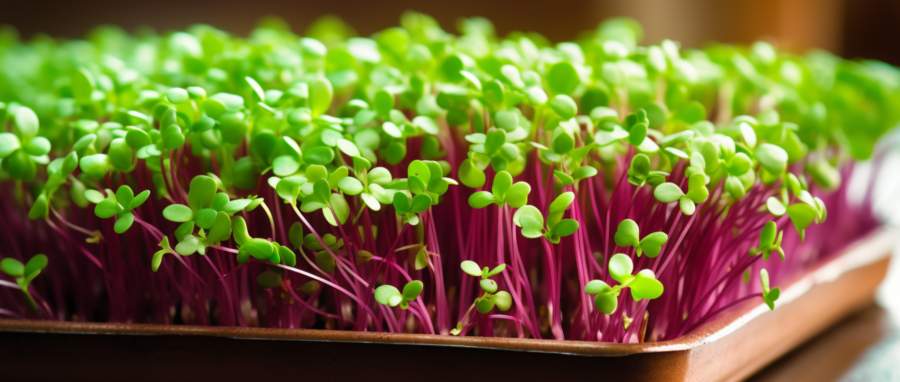Microgreens: A Kitchen Garden Revolution

A Miniature Marvel of Nutritional Proportions
Imagine, if you will, a verdant, lush forest filled with vibrant flora and teeming with life, a veritable urban utopia of greenery. Now imagine that this thriving Eden exists not in some far-flung, exotic locale, but right in the comfort of your own kitchen. No, my friends, I have not gone mad (though that's certainly up for debate); rather, I speak of the illustrious world of microgreens, those diminutive darlings that have taken the culinary realm by storm.Microgreens, for the uninitiated, are the tender, young shoots of edible plants, harvested just after the first leaves have unfurled. Packed with powerful flavor profiles and nutritional benefits, these Lilliputian leaflets are a plant-based panacea to the bland, lifeless salads of yesteryear.
From Humble Seed to Gourmet Green
Once a niche curiosity relegated to the fringe of the food world, microgreens have found their way into the hearts and stomachs of gastronomes the world over. Like many great culinary tales, the rise of the microgreen can be traced back to an unsuspecting California restaurant in the early 1980s, where the innovative use of these tiny sprouts first dazzled the palates of eager diners. Oh, how far we've come since those heady days, with microgreens now a mainstay of haute cuisine and home kitchens alike.Despite their dainty appearance, these edible greens are culinary chameleons, with a versatility that belies their size. Sprinkle them over your avocado toast for a burst of vibrant color and flavor, or fold them into an omelette for the ultimate breakfast indulgence. And lest you think these pocket-sized plants are merely a frivolous garnish, know that microgreens are nutritional powerhouses, boasting higher concentrations of vitamins and minerals than their fully grown counterparts.
DIY: The Microgreen Methodology
Perhaps the most enchanting aspect of the microgreen movement is its accessibility. The growing process is remarkably simple, requiring minimal space, supplies, and expertise, making it an ideal endeavor for even the most botanically challenged among us.- First, select your seeds. The world of microgreens is vast and varied, with popular options including arugula, basil, beet, broccoli, cilantro, kale, radish, and more. Mix and match to your heart's content, creating a custom blend to suit your culinary whims.
- Next, prepare your growing medium. A shallow container filled with pre-moistened soil will suffice. Scatter your seeds evenly across the surface, then lightly cover with a thin layer of soil or vermiculite. Mist the surface with water to ensure a cozy, damp environment for your burgeoning sprouts.
- Once your seeds are nestled snugly in their bed, place the container in a warm, well-lit area, or use a grow light if natural sunlight is scarce. A bit of patience is required at this stage, as you eagerly await the first signs of life emerging from the soil. Keep the surface consistently moist, but take care not to overwater your fledgling greens.
- After a week or two, depending on the variety, your microgreens will be ready to harvest. Simply snip them off at the soil line, give them a gentle rinse, and they're ready to be savored - no green thumb necessary!
A Revolution in Flavor and Nutrition
The popularity of microgreens shows no signs of waning, and for good reason. These vibrant, nutrient-dense greens have shaken the very foundations of traditional salad preparation, ushering in a new era of taste bud tantalization. Gone are the days of desolate plates of limp lettuce, replaced by a verdant landscape of microgreen goodness.As if their flavor and nutritional prowess weren't reason enough to cultivate your own microgreen menagerie, the ease and simplicity of the growing process make it a delightful endeavor for gardeners of all experience levels. So go forth and sow your seeds, dear reader, and revel in the revolutionary movement that is the microgreen.
Article kindly provided by yourhomengarden.org
Latest Articles
- The Step-By-Step Process of Turning a Garden Vision into Reality
- Rain Doesn't Fall Straight: Why Roof Shape and Wind Matter More Than You Think
- How Fire Pit Design Quietly Shapes Human Connection
- Invisible Passengers Who Never Pay the Fare
- When the Ground Has Opinions: Learning to Hear Tree-Soil Conversations
- When Windows Sweat: What Condensation Reveals About Your Home's Hidden Climate
- Vertical Micro-Oasis for Kitchen Herbs in Tight Urban Spaces
- Why Clean Workspaces Quietly Boost Creativity
- Color-Coding Your Backyard: a Homeowner's Guide to Safe DIY Marking
- Invisible Safety in Bathrooms that Still Feel Like a Spa
- How Orientation Shapes Your Extension's Energy Efficiency
- How Floor Patterns Change How a Room Is Perceived
- Angles, Curves and the Secret Life of Staircases
- How Outdoor Illumination Shapes Local Insect Populations
- Matching Wooden Outdoor Building Walls to Weather, Work and Whim
- The Real Value of Unbuilt Structures in Backyard Projects
- The Hidden Costs of Neglecting Yard Waste
- Why Your Fireplace Isn't Warming Your Space
- Why Your Driveway Is Secretly Plotting Against Your Garden
- Creating Calm Interiors That Still Feel Lived-In and Layered
- Interior Design
- Home Improvement
- Gardening
- Home Organization
- Home Maintenance
- DIY Crafts
- Kitchen and Dining
- Bathroom Design
- Home Security
- Home Automation
- Green Living
- Home Office
- Home Decor
- Garden Design
- Pet Care
- Home Technology
- Landscaping
- Home Energy Efficiency
- Home Cleaning
- Home Safety
- Home Exterior
- Home Insulation
- Home Buying
- Home Selling
- Renting
- Tradespeople
- Garage
- Bedroom
- Painting and Decorating
- Plumbing and Drainage

